Physical Address
304 North Cardinal St.
Dorchester Center, MA 02124
Physical Address
304 North Cardinal St.
Dorchester Center, MA 02124
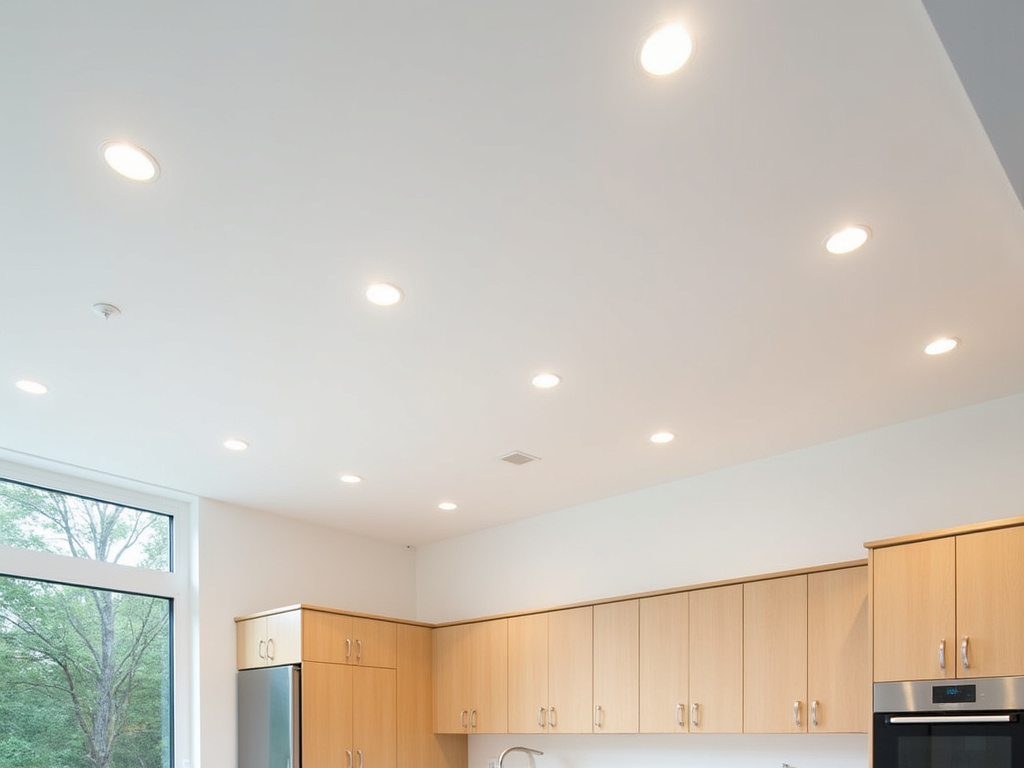
Light has always held profound significance in Islamic architecture, where it symbolizes divine presence and transforms spaces into sanctuaries of peace and harmony. In our modern kitchens, thoughtful lighting serves a similar purpose – creating an atmosphere that nurtures both body and soul. As we explore these kitchen lighting ideas, we’ll discover how to blend functionality with beauty, creating spaces that radiate warmth and welcome.
The concept of suspended light has deep roots in Islamic architecture, where ornate lamps would illuminate sacred spaces. Today’s statement pendant lights carry forward this tradition of elevated illumination, serving as both functional fixtures and artistic focal points in our kitchens.
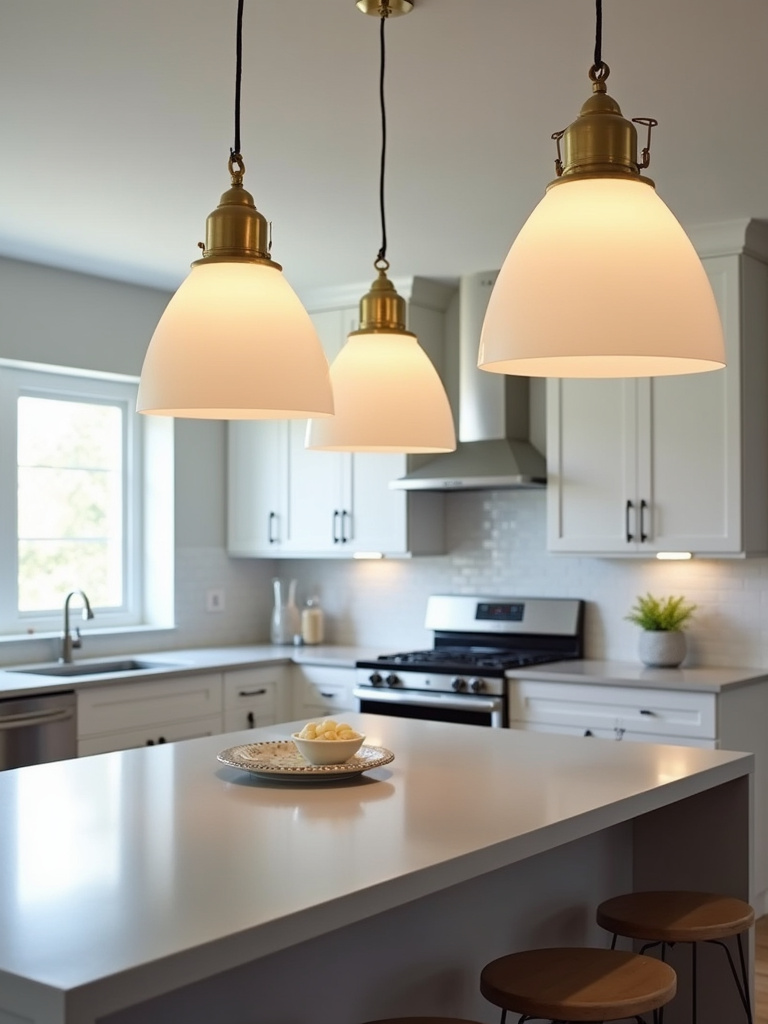
When selecting pendant lights for your kitchen island, consider the principle of proportion that’s so fundamental in Islamic design. Choose pendants approximately one-third the width of your island, spacing them 24-30 inches apart to create a harmonious rhythm. For optimal functionality and aesthetic balance, suspend them 30-36 inches above the countertop, adjusting slightly based on your ceiling height and family members’ stature.
To infuse your space with personality, consider mixing pendant styles while maintaining a cohesive color palette – a modern interpretation of the intricate patterns found in traditional Islamic design. Oversized pendants can create dramatic impact in larger kitchens, filling the visual space with presence and purpose.
The dance of light and shadow created by pendant lights reminds us of the mashrabiya screens in Islamic architecture, leading us to explore another essential layer of kitchen illumination – under-cabinet lighting.
In Islamic culture, the preparation of food is considered a blessed activity. Under-cabinet LED lighting honors this tradition by providing clear, focused illumination for cooking tasks while creating an ethereal glow that elevates the everyday to the extraordinary.
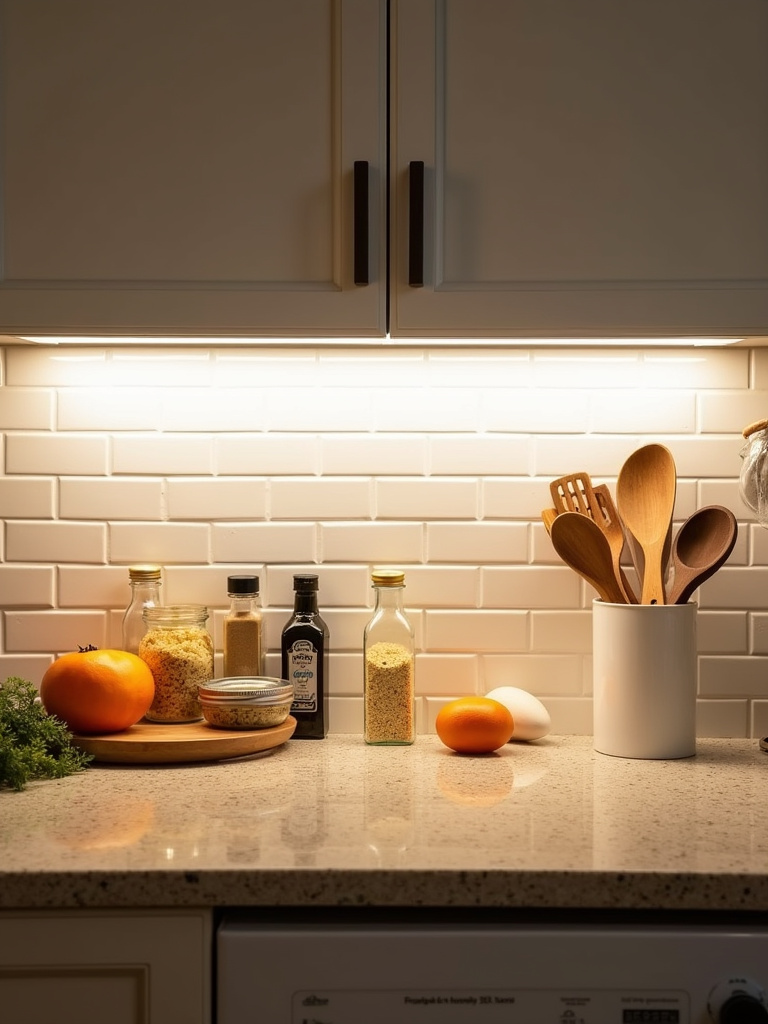
Modern LED under-cabinet lights offer remarkable benefits: they’re energy-efficient, produce minimal heat, and provide consistent, even illumination. Installation is often straightforward, with both adhesive-backed and screw-mounted options available. Whether you choose plug-in or hardwired versions, these lights transform your countertop workspace into a well-lit sanctuary for culinary creation.
For those seeking to add an element of joy and customization, consider color-changing LED strips. Like the vibrant tiles in Islamic architecture, these can infuse your kitchen with beautiful hues, creating different moods for various occasions.
As we seek to create a harmonious balance of light in our kitchens, let’s turn our attention skyward to explore the subtle beauty of recessed lighting.
In Islamic architecture, domed ceilings often feature small openings that allow natural light to filter down like stars in the night sky. Modern recessed lighting captures this same celestial quality, providing gentle illumination that seems to rain down from above.

The key to successful recessed lighting lies in thoughtful spacing. A general guideline is to space lights approximately the same distance apart as the height of your ceiling – for instance, in an 8-foot ceiling, aim for 8-foot spacing between lights. However, like the geometric patterns in Islamic design, this spacing should follow a deliberate rhythm that accounts for your kitchen’s unique layout and needs.
LED bulbs are the ideal choice for recessed lighting, offering both efficiency and flexibility. Choose warm white (2700K-3000K) for a cozy, welcoming atmosphere reminiscent of candlelight, or cool white (3500K-4000K) for a crisp, modern feel.
From the heavenly pattern of recessed lights, we move to a more dynamic lighting solution that allows us to direct light where it’s needed most.
Just as traditional Islamic architecture uses light to guide visitors through spaces, track lighting serves as a contemporary way to direct illumination along purposeful paths in your kitchen. This versatile lighting solution offers flexibility in positioning and aiming light exactly where it’s needed.
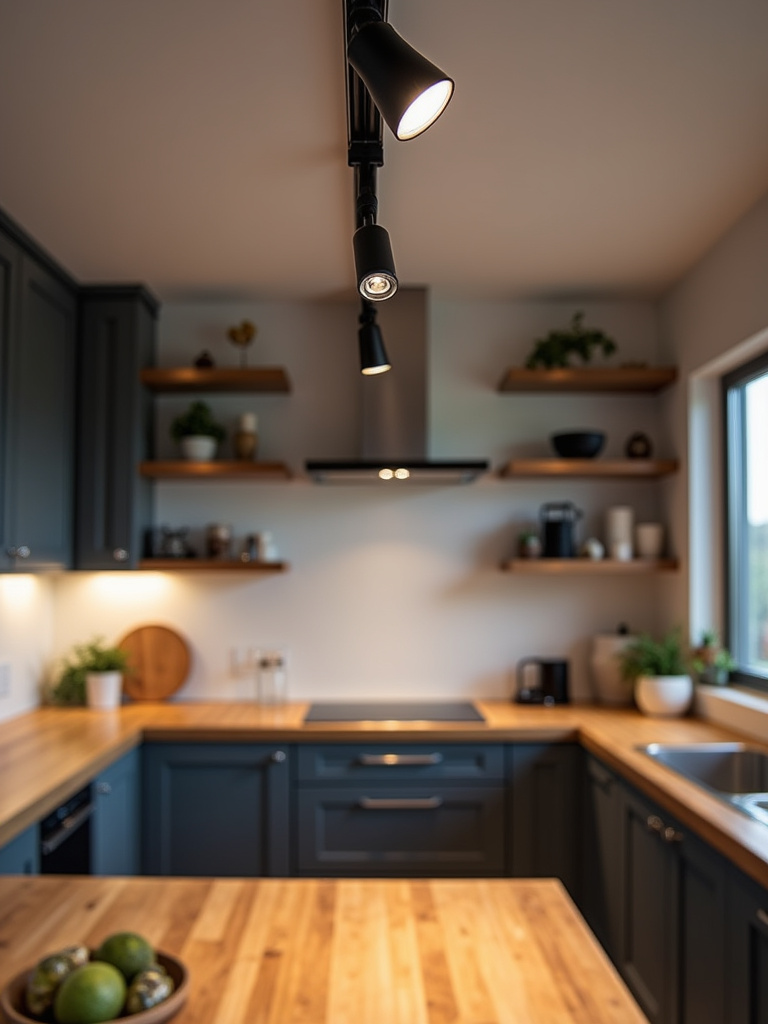
Track lighting’s adaptability makes it particularly valuable in kitchens with unique layouts or specific areas requiring focused illumination. Individual light heads can be adjusted and repositioned along the track, allowing you to create precise lighting schemes that evolve with your needs. When selecting track heads, consider the interplay of function and aesthetics – spotlights for focused task lighting, floodlights for broader ambient light, or decorative heads that add visual interest.
Consider using track lighting to highlight a gallery wall or open shelving, creating a modern interpretation of the illuminated niches found in traditional Islamic architecture. The ability to wash walls with light or highlight specific features adds depth and dimension to your kitchen space.
From the modern versatility of track lighting, let’s explore how to bring warmth and traditional charm into your kitchen lighting design.
The farmhouse chandelier, with its simple forms and honest materials, shares a spiritual kinship with Islamic design principles that celebrate beauty through authenticity and craftsmanship. These fixtures typically feature natural materials like wood and metal, often in wrought iron or oil-rubbed bronze finishes, creating a bridge between rustic charm and timeless elegance.
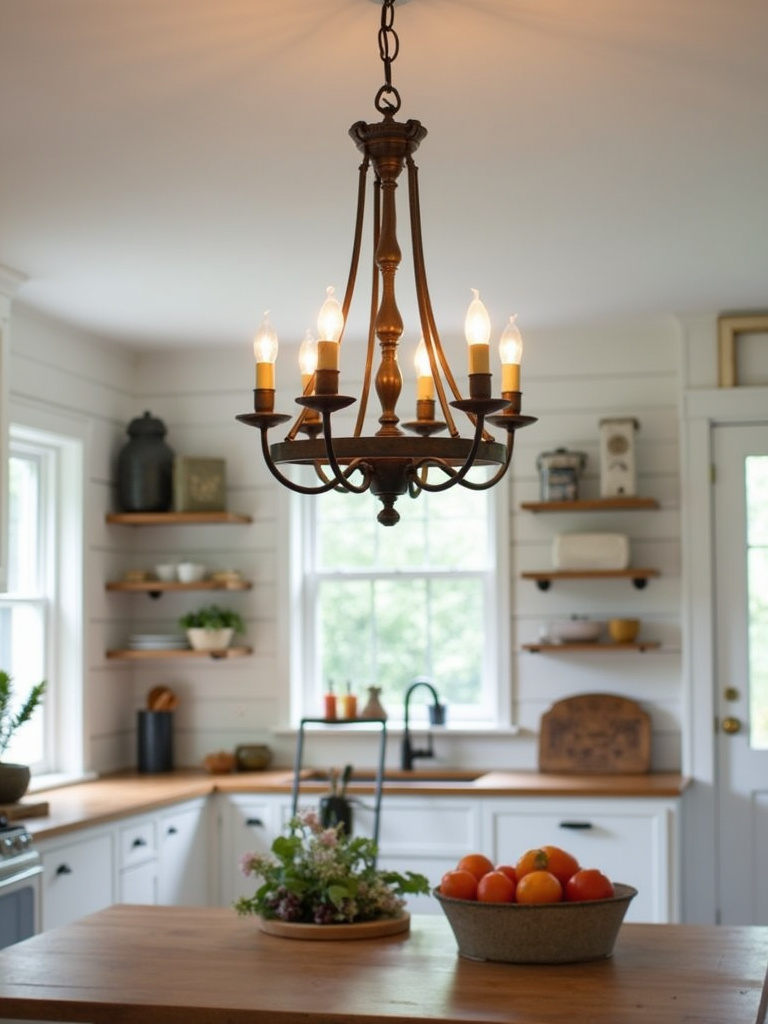
Choosing the perfect location for your farmhouse chandelier requires careful consideration of both space and function. These fixtures excel as central focal points over kitchen islands or dining areas within the kitchen, where they can cast their warm glow over gathering spaces. The key is selecting a size that maintains proper proportion with your space – much like the careful scaling of geometric patterns in Islamic design.
For a truly harmonious look, consider combining your farmhouse chandelier with complementary sconces or pendants, creating a layered lighting scheme that adds depth and character to your kitchen while maintaining visual cohesion.
As we transition from the warmth of farmhouse style, let’s explore how industrial elements can add strength and character to your kitchen lighting.
The industrial cage pendant embodies the Islamic design principle of finding beauty in structural honesty. These fixtures celebrate their fundamental elements – metal, glass, and light – creating a powerful statement through simplicity and function.
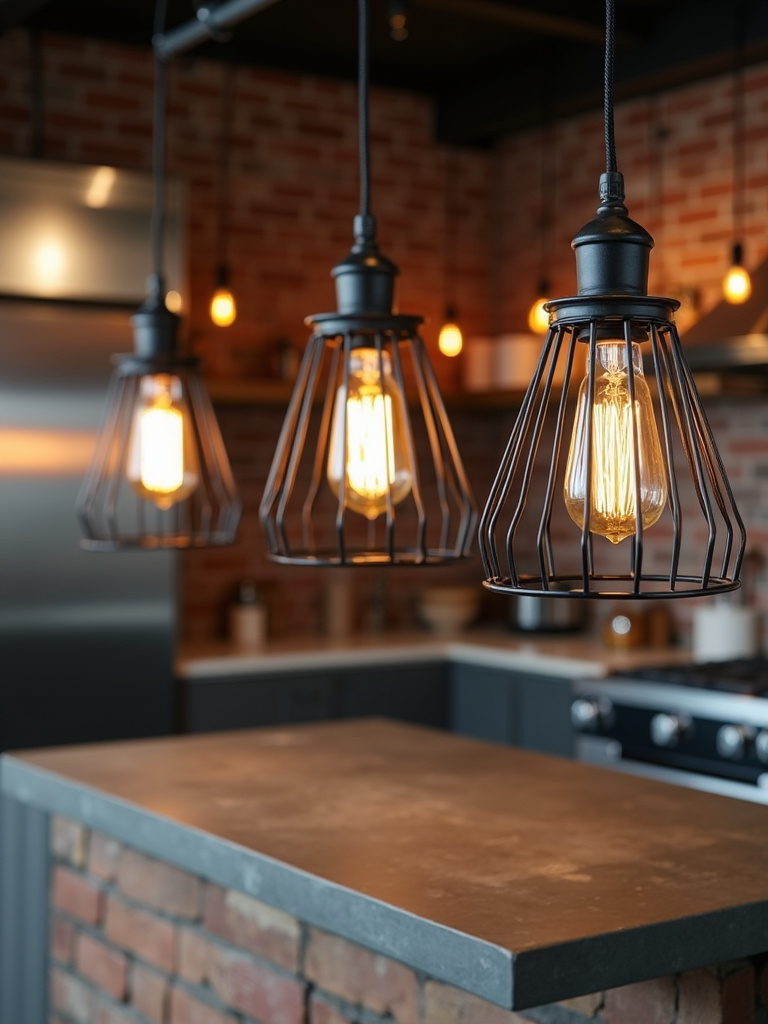
Industrial lighting is characterized by exposed metals, cage-like designs, and Edison bulbs that cast a warm, inviting glow. These fixtures work particularly well over kitchen islands, breakfast bars, or sinks, where their robust design adds visual weight while providing focused task lighting. The open cage design allows light to flow freely while creating interesting shadow patterns, reminiscent of the intricate shadows cast by traditional mashrabiya screens.
When incorporating industrial cage pendants, consider how they interact with other materials in your kitchen. The combination of exposed brick or concrete walls with these fixtures creates a compelling dialogue between raw materials, much like the material interplay in traditional Islamic architecture.
From the bold presence of industrial lighting, let’s explore how to create atmosphere through the subtle art of light control.
In Islamic design, the interplay of light and shadow creates rhythm and movement throughout a space. Dimmable lighting brings this ancient wisdom into the modern kitchen, allowing us to adjust light levels to match our activities and moods throughout the day.
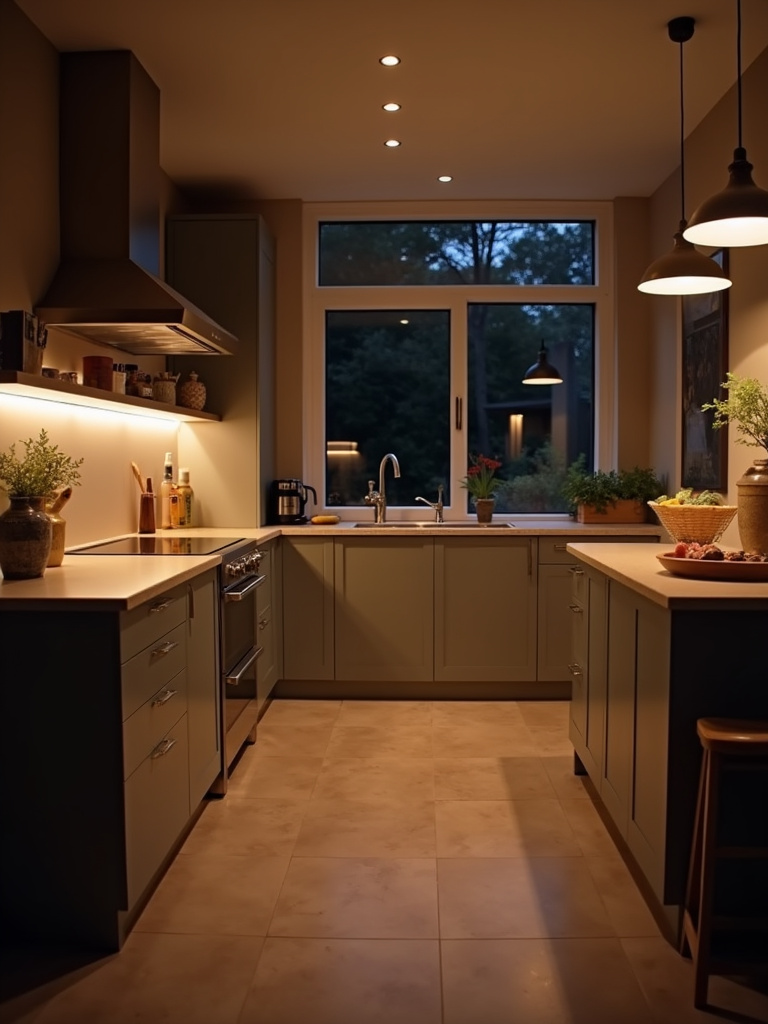
The versatility of dimmable lighting cannot be overstated. From bright, clear light for food preparation to softly glowing ambiance for evening gatherings, dimmable fixtures allow your kitchen to transform throughout the day. Most modern kitchen lighting can be made dimmable, including recessed lights, pendant lights, chandeliers, and even some LED strips, providing ultimate control over your lighting environment.
Consider installing a smart dimming system to control your kitchen lighting remotely or through voice commands. Like the carefully calibrated light in traditional Islamic architecture, this modern technology allows you to create perfect lighting “scenes” for different occasions and times of day.
As we consider how to further layer light in our kitchens, let’s explore the gentle illumination provided by wall-mounted fixtures.
Wall sconces in Islamic architecture traditionally served as beautiful vessels of light, creating rhythm along corridor walls and illuminating important spaces. In the modern kitchen, sconces continue this legacy, providing both functional light and decorative accent to our vertical surfaces.
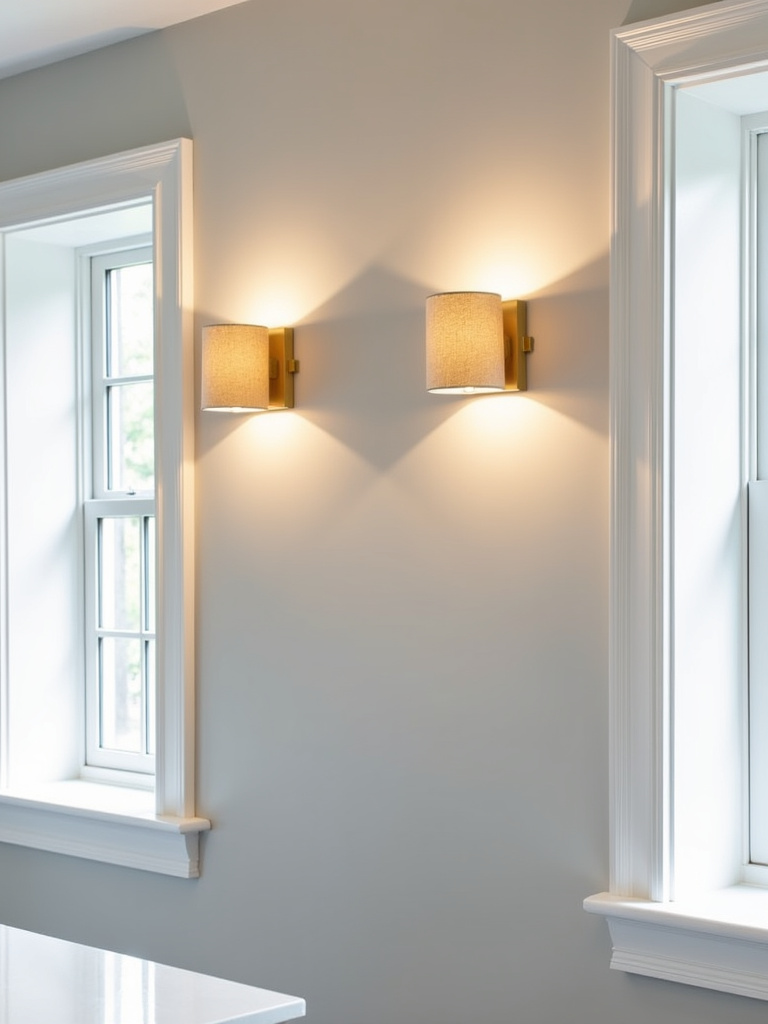
The placement of kitchen sconces requires careful consideration, much like the placement of traditional Islamic wall lamps. Optimal locations include walls above countertops, flanking windows, or near doorways. When mounted at the proper height – typically 60-66 inches from the floor – sconces create a beautiful interplay of light and shadow while providing useful illumination for kitchen tasks.
Choose sconces that complement your kitchen’s overall Design Aesthetic, whether modern and minimalist or traditional and ornate. Like the varied styles of Islamic metalwork, today’s sconces come in a wide range of designs that can enhance any kitchen style while maintaining their essential function of bringing light to life.
From the gentle glow of wall sconces, we’ll next explore lighting solutions for kitchens with lower ceilings…
In Islamic design, there is beauty in humility and practicality. Flush mount lights embody this principle perfectly, offering elegant illumination without demanding attention. These fixtures are particularly valuable in kitchens with lower ceilings, where they provide essential light while maintaining clean lines and open sight lines.
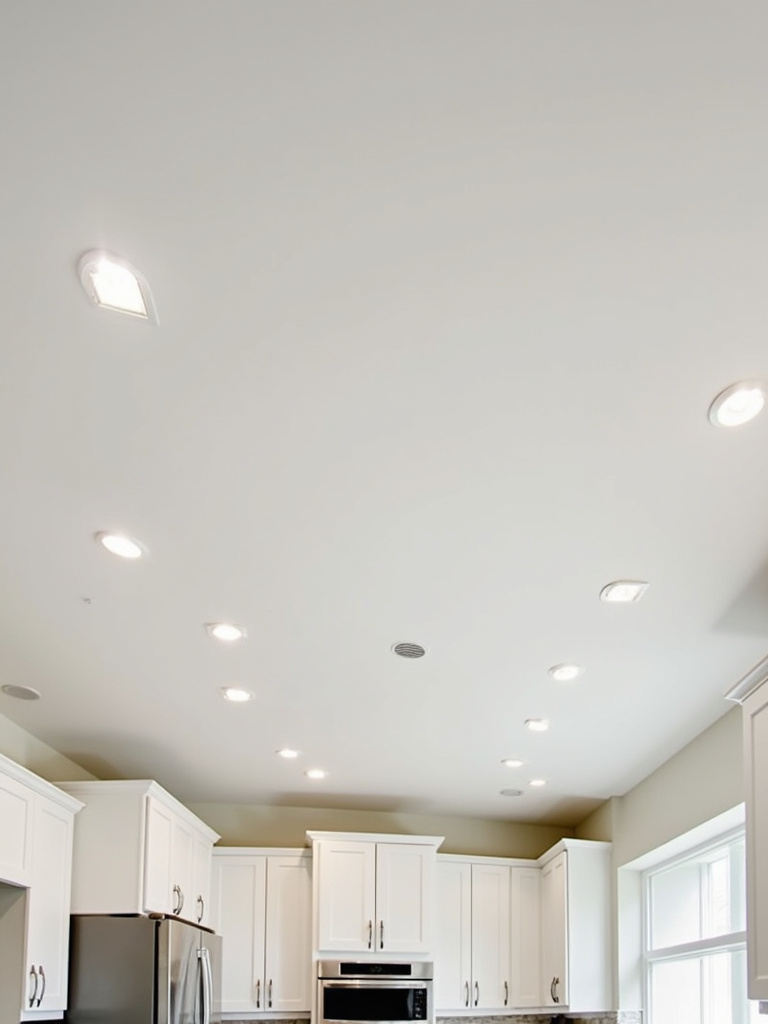
Despite their low profile, flush mount lights need not be plain or uninspiring. Today’s options range from simple, functional designs to elaborate fixtures that incorporate geometric patterns and interesting materials. The key is selecting a style that complements your kitchen’s aesthetic while providing adequate illumination for the space.
Consider combining flush mount lights with other lighting types, such as under-cabinet fixtures or wall sconces, to create a layered lighting scheme that maximizes functionality while maintaining visual harmony. This approach reflects the Islamic design principle of creating beauty through balanced composition.
From the subtle presence of flush mount fixtures, let’s explore a more contemporary approach to kitchen island lighting.
The linear suspension light represents a modern interpretation of traditional Islamic geometric patterns, creating clean, horizontal lines of light that bring order and harmony to kitchen spaces. These elongated fixtures are particularly well-suited for kitchen islands and dining areas, where they provide both focused illumination and architectural interest.
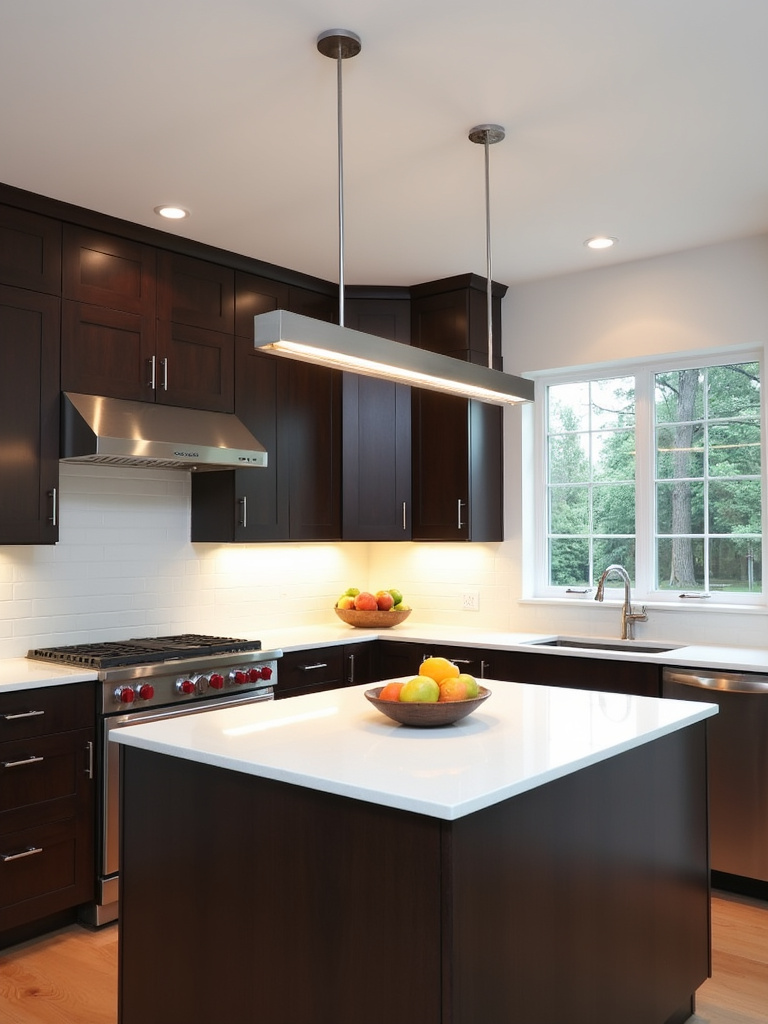
When selecting a linear suspension light for your island, consider the Islamic principle of proportion. The fixture should typically measure about two-thirds to three-quarters the length of your island, creating a balanced relationship between light and space. This careful sizing ensures adequate illumination while maintaining visual harmony.
For a truly contemporary look, choose a linear suspension light with a sleek metal finish, such as brushed nickel or matte black. These finishes offer a modern take on the metalwork traditionally found in Islamic architecture, bringing timeless elegance to your kitchen design.
As we move from contemporary lines to classic forms, let’s explore the timeless appeal of globe lighting.
The perfect sphere has long held special significance in Islamic architecture, symbolizing unity and completeness. Globe pendant lights bring this symbolic geometry into the modern kitchen, offering a harmonious blend of form and function that suits any style.
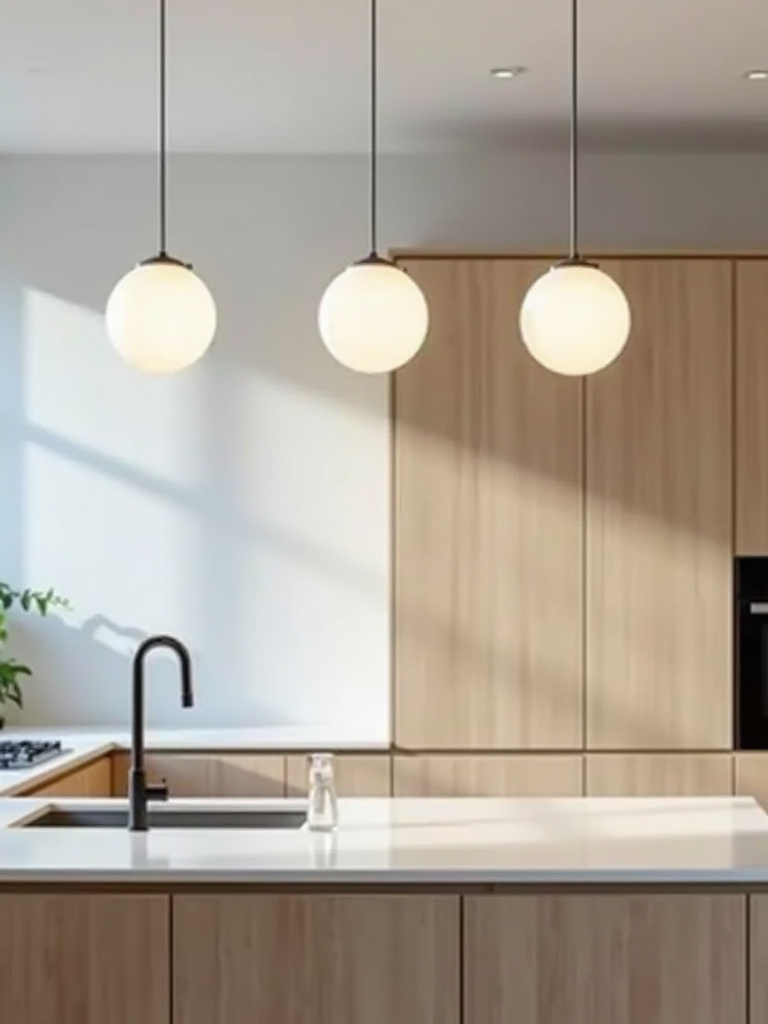
The versatility of globe pendants lies in their simple yet profound shape. Available in various sizes, materials, and finishes, these fixtures can be used individually over a sink, grouped in clusters above an island, or arranged in a linear pattern along a peninsula. Their spherical form distributes light evenly in all directions, creating a soft, welcoming atmosphere reminiscent of traditional lanterns.
Consider exploring different glass treatments for your globe pendants. Clear glass provides bright, direct light, while frosted or opaque glass offers a softer, more diffused glow – much like the filtered light through traditional Islamic screens.
From the serene simplicity of globe pendants, let’s turn our attention to creating an intimate dining space within the kitchen.
In Islamic culture, sharing meals is a sacred activity that strengthens family and community bonds. A breakfast nook chandelier creates a dedicated space for this important ritual, defining an intimate area within the kitchen where people can gather and connect.
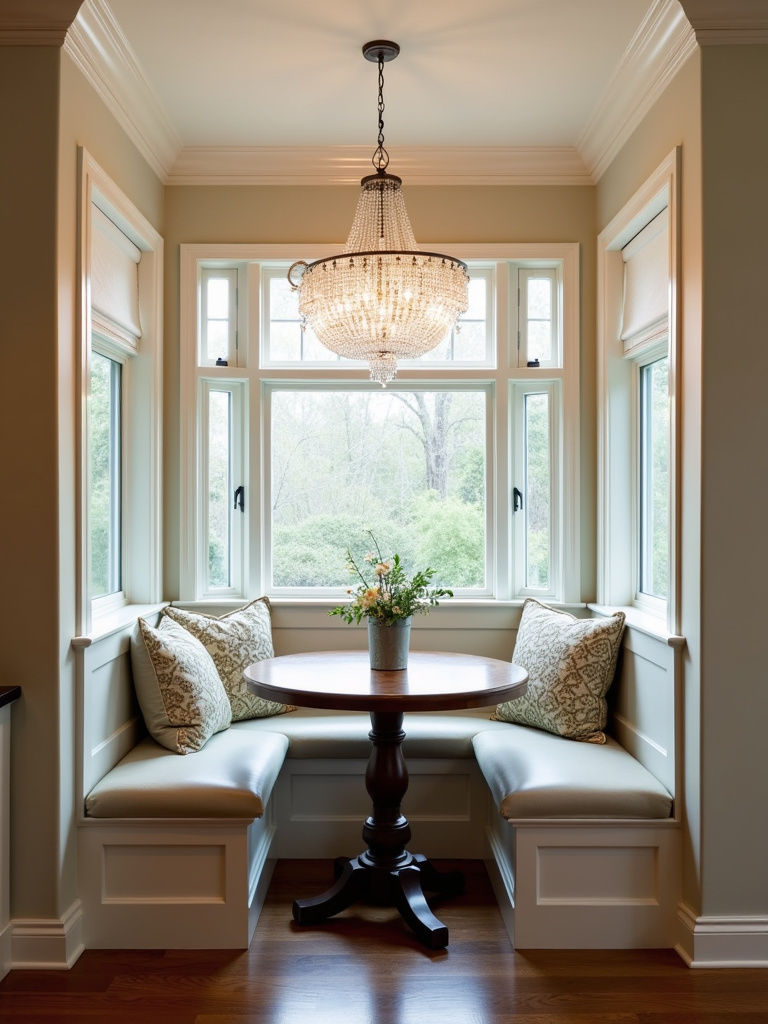
The choice of chandelier for your breakfast nook should reflect both the scale of the space and its importance in daily life. Consider smaller chandeliers or mini-chandeliers that provide adequate light without overwhelming the area. The fixture should complement your kitchen’s overall design while creating a distinct atmosphere for dining and conversation.
When selecting and positioning your breakfast nook chandelier, consider how it will interact with natural light throughout the day. Like the carefully planned lighting in mosque architecture, your chandelier should work in harmony with sunlight to create beautiful effects at different times.
From intimate dining spaces, let’s explore how to illuminate the beautiful objects that tell your kitchen’s story.
In Islamic design, everyday objects are often elevated to art through thoughtful display and illumination. Open shelving lighting continues this tradition, transforming functional storage into beautiful vignettes that showcase your kitchen’s personality.

The key to successful open shelving lighting lies in choosing the right type and placement of fixtures. LED strip lights, puck lights, or small spotlights can be used to create even illumination that highlights your displayed items without creating harsh shadows or glare. The goal is to create a warm, inviting glow that draws attention to the beauty of your everyday objects.
Consider using warm white LED strip lights under each shelf to create a consistent glow that enhances the visual appeal of your displayed items. This approach reflects the Islamic design principle of using light to reveal beauty in the ordinary.
From showcasing beautiful objects, let’s move to a more practical but equally important aspect of kitchen lighting.
In Islamic tradition, the storage of food is treated with respect and care. Modern pantry lighting continues this mindful approach, using motion-sensor technology to provide convenient, efficient illumination that helps prevent waste and promotes organization.
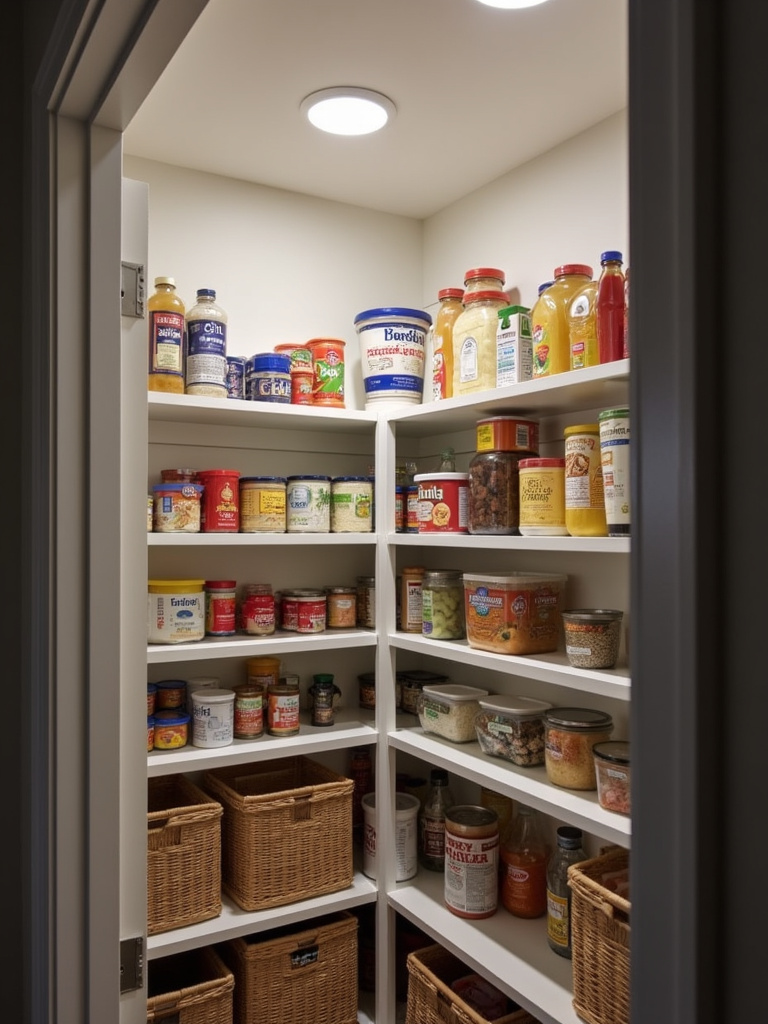
Motion-sensor lights in the pantry offer both practical and environmental benefits. They provide hands-free illumination when you need it and automatically turn off when you leave, saving energy and adding convenience. Options like battery-operated LED puck lights or strip lights are easy to install and maintain, making them perfect for retrofit applications.
Consider installing motion-sensor lights inside drawers and pull-out shelves as well, ensuring every corner of your pantry is well-lit and accessible. This attention to detail reflects the Islamic principle of mindful stewardship of resources.
From the practical lighting of storage spaces, let’s focus on one of the kitchen’s most important work areas.
In Islamic tradition, water and cleanliness hold special significance. Dedicated sink lighting honors this tradition by providing focused illumination for one of the kitchen’s most frequently used areas. Proper lighting here enhances both the functional and aesthetic aspects of your sink area.
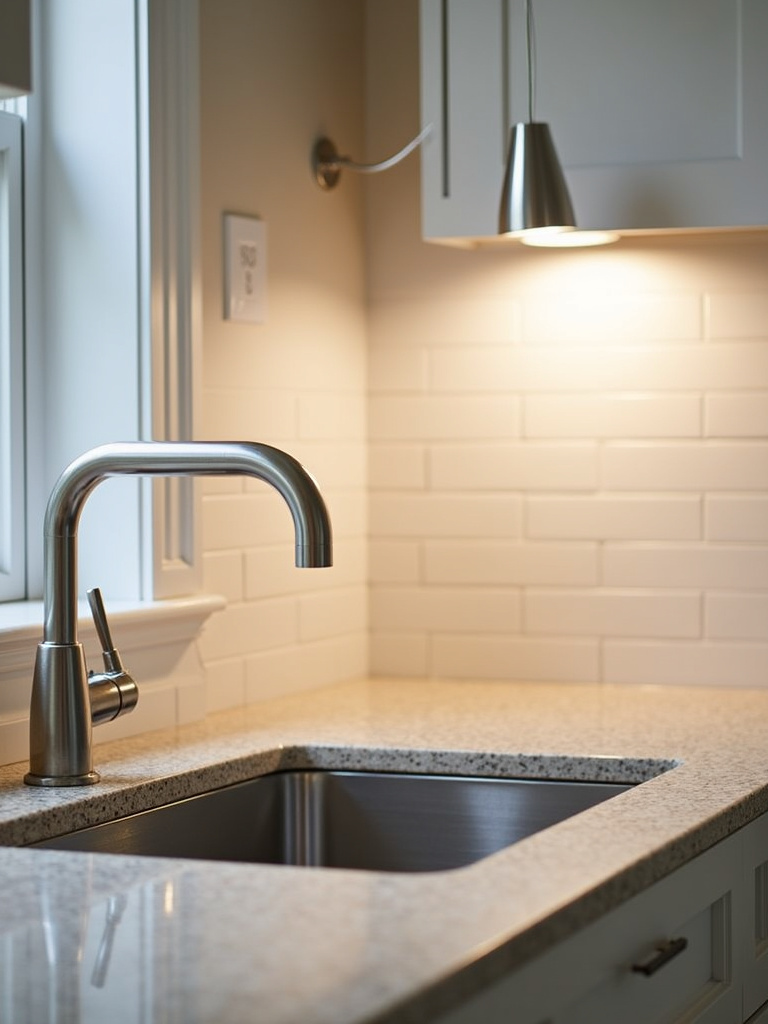
Choose lighting fixtures that direct light downward onto the sink basin, eliminating shadows that can make tasks more difficult. Pendant lights, recessed lights, or under-cabinet lights positioned above the sink are all excellent options. Consider water-resistant or damp-rated fixtures to ensure safety and longevity in this potentially moist environment.
A small, adjustable arm sconce or stylish pendant light can add both task lighting and decorative appeal to your sink area, transforming a purely functional space into one that celebrates the importance of water in our daily lives.
From manual control of sink lighting, let’s explore how modern technology can enhance our kitchen lighting experience.
Just as Islamic architecture used innovative techniques to control light, modern smart lighting systems offer unprecedented control over our kitchen’s illumination. These systems combine convenience, energy efficiency, and customization capabilities to create perfectly lit spaces for any occasion.
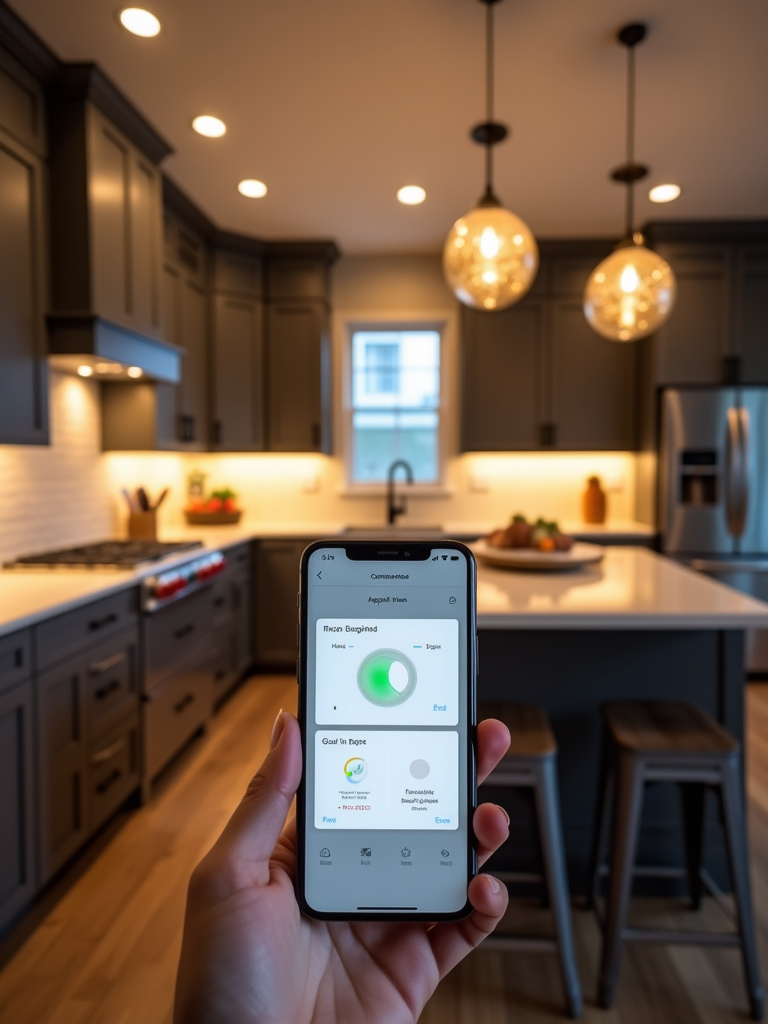
Smart lighting allows you to control brightness, color temperature, and timing through smartphone apps or voice commands. You can create preset scenes for different activities, schedule lights to match your daily routine, and even integrate lighting with other smart home features. This technology makes it easier than ever to achieve the perfect balance of light for cooking, dining, or entertaining.
Consider programming your smart lighting to automatically brighten in the morning and dim in the evening, following the natural rhythms of the day. This approach reflects the Islamic appreciation for the natural cycles of light and dark.
From the high-tech control of smart systems, let’s explore how to maximize nature’s own perfect light source.
Natural light holds profound significance in Islamic architecture, where it’s seen as a manifestation of divine presence. In modern kitchen design, maximizing natural light creates spaces that feel more open, welcoming, and connected to the natural world.

The benefits of natural light extend beyond mere illumination. It enhances the visual appeal of your kitchen, making colors appear more vibrant and spaces feel larger. More importantly, natural light has been shown to improve mood and well-being, creating a more pleasant environment for cooking and gathering.
Consider incorporating large windows, skylights, or glass doors in your kitchen design to maximize natural light penetration. Use light-colored surfaces and reflective materials to help bounce daylight deeper into the space, creating a bright and uplifting atmosphere throughout the day.
From nature’s perfect light, let’s explore how to choose the right artificial light temperature for your space.
In Islamic design, light is used to create different moods and atmospheres within a space. Understanding the difference between warm and cool lighting allows you to achieve similar effects in your modern kitchen, crafting the perfect ambiance for various activities and times of day.
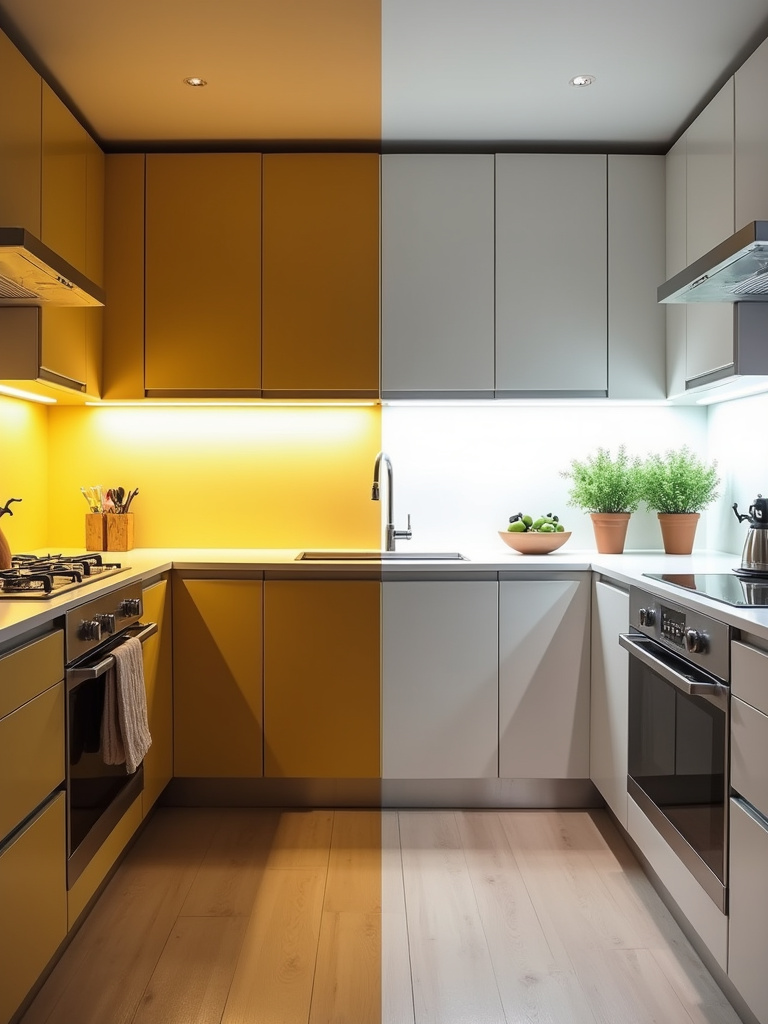
Warm white lighting (2700K-3000K) creates a cozy, inviting atmosphere with its subtle yellow hue, perfect for general ambient lighting and creating a welcoming environment. Cool white lighting (3500K-4000K), with its brighter, more neutral tone, excels in task areas where clear visibility is essential. The key is finding the right balance between these temperatures to support both function and atmosphere in your kitchen.
Consider using both warm and cool lighting in different areas of your kitchen, creating distinct zones for various activities while maintaining overall harmony in the space. Like the carefully filtered light in traditional Islamic architecture, this approach allows you to create different moods and experiences within a single space.
From temperature considerations, let’s explore how to create a complete and balanced lighting scheme.
The concept of layered lighting reflects the Islamic principle of creating harmony through multiple elements working together. Just as traditional Islamic architecture uses different types of openings and screens to filter and direct light, modern kitchen lighting relies on three essential layers: ambient, task, and accent lighting.

Ambient lighting provides general illumination, ensuring safe movement and overall visibility. Task lighting focuses bright, clear light on work areas for cooking, cleaning, and food preparation. Accent lighting adds visual interest and depth, highlighting architectural features or decorative elements. When properly combined, these layers create a kitchen that is both functional and beautiful.
Use dimmers on different layers of lighting to customize the overall brightness and mood in your kitchen for various occasions. This flexibility allows you to create the perfect atmosphere for everything from morning coffee to evening gatherings.
From the harmony of layered lighting, let’s explore how to make a bold statement with your kitchen lighting.
Like the dramatic centerpieces in Islamic architecture, statement pendant lights serve as focal points that command attention and define space. These fixtures go beyond mere illumination to become artistic elements that express personal style and elevate the entire kitchen design.
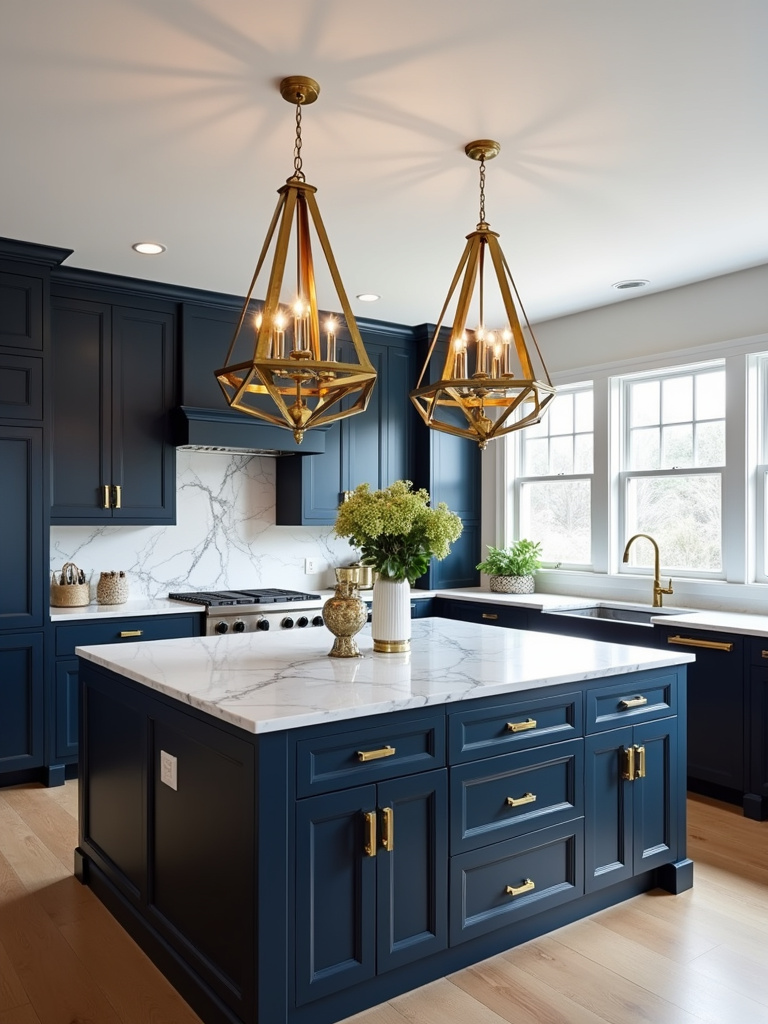
When selecting statement pendants for your kitchen island, consider both their visual impact and practical function. Choose fixtures that complement your kitchen’s style while providing adequate task lighting. The scale should be proportional to your island – large enough to make a statement but not so overwhelming that they dominate the space.
For maximum impact, consider oversized geometric pendants in bold metallic finishes, or create a dynamic arrangement using multiple pendants of varying sizes and heights. This approach reflects the complex geometries and rhythmic patterns found in Islamic design.
From bold statements, let’s explore how to incorporate natural elements into your lighting design.
In Islamic design, natural materials are celebrated for their inherent beauty and connection to the divine. Wood beam lighting brings this appreciation for natural elements into the modern kitchen, combining structural beauty with functional illumination.
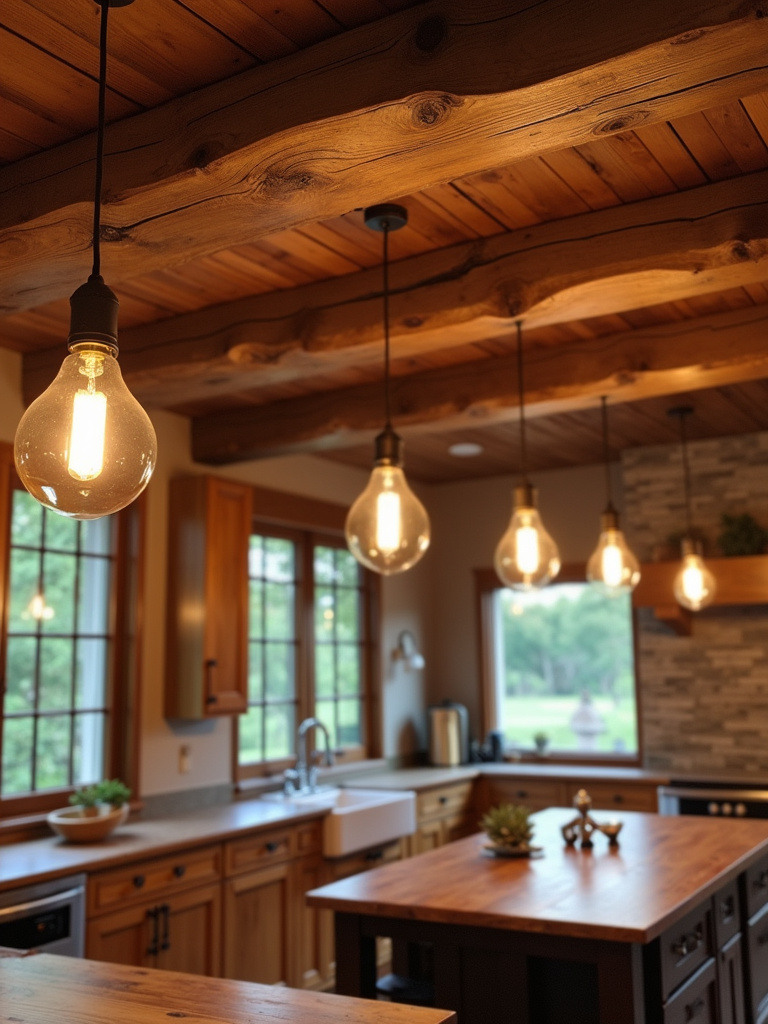
Installing reclaimed wood beams across your kitchen ceiling or above an island creates opportunities for creative lighting solutions. Pendant lights can be suspended from the beams, or wiring can be concealed within hollowed-out beams for a clean look. The natural warmth of wood adds character and depth to your kitchen while providing a perfect platform for lighting fixtures.
Consider combining wood beam lighting with industrial-style pendants or Edison bulbs to create an interesting fusion of natural and industrial elements. This combination honors both traditional materials and modern functionality.
From natural wood elements, let’s explore how metallic finishes can add warmth and sophistication to your kitchen lighting.
Brass has long been cherished in Islamic design for its warm glow and ability to reflect light beautifully. In modern kitchen lighting, brass accents add a touch of timeless elegance while providing a warm, golden tone that enhances the overall atmosphere.
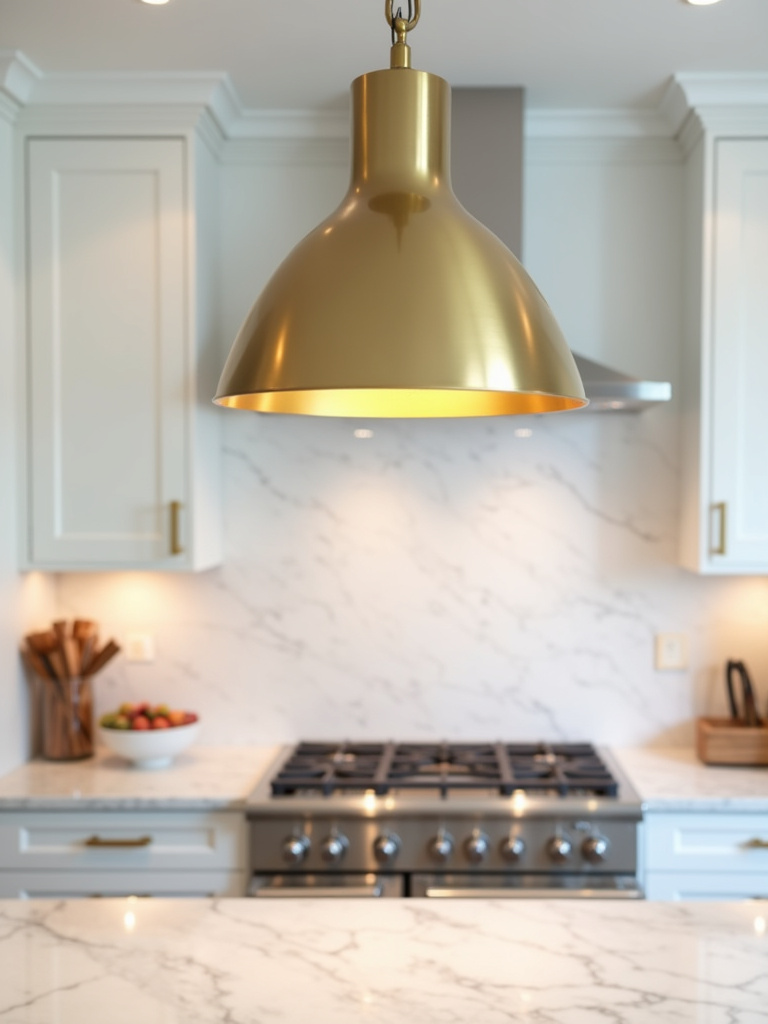
The versatility of brass makes it an excellent choice for kitchen lighting fixtures. Whether you choose pendant lights, chandeliers, sconces, or flush mount fixtures, brass finishes can complement various kitchen styles. The metal’s warm undertones work particularly well with both light and dark color palettes, adding depth and sophistication to your space.
Balance brass accents with other metals in your kitchen for a layered, collected look. Mix brass with stainless steel for a modern approach, or combine it with warm wood tones for a more traditional feel.
From warm metallic tones, let’s explore how darker finishes can create dramatic contrast in your kitchen.
While Islamic design often celebrates intricate patterns, it also recognizes the power of bold contrasts. Black metal lighting fixtures bring this principle into the modern kitchen, offering striking visual interest and architectural definition to your space.
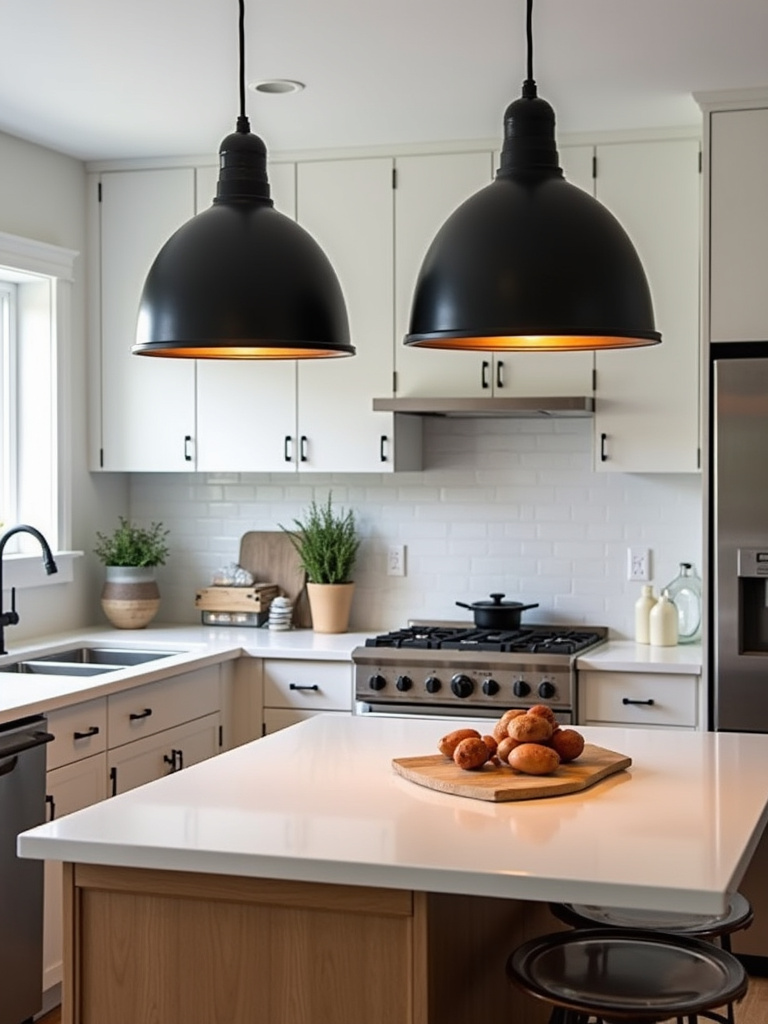
This lighting works particularly well in kitchens with light-colored cabinetry or walls, where it creates dramatic contrast and adds visual weight to the design. Choose from industrial cage pendants, sleek track lighting, minimalist sconces, or modern chandeliers to achieve your desired effect.
When incorporating black metal lighting, consider how it will interact with other elements in your kitchen. The contrast between black fixtures and lighter surfaces can create a dynamic interplay of light and shadow, much like the dramatic effects achieved in traditional Islamic architecture.
From bold contrasts, let’s conclude our journey with a celebration of color in kitchen lighting.
The use of colored light through stained glass windows is a hallmark of Islamic architecture, creating beautiful patterns and atmospheric effects. Modern colorful pendant lights bring this joyful celebration of color into today’s kitchens, adding personality and visual interest to your space.
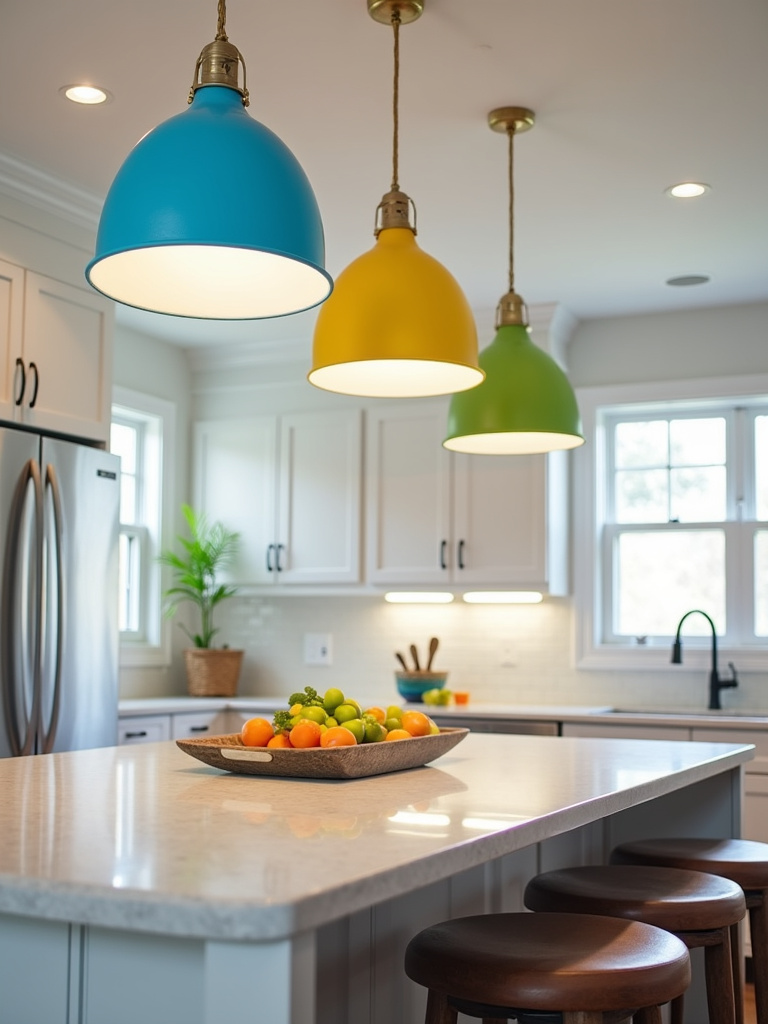
Choosing colorful pendant lights allows you to express your individual style while creating unique lighting effects in your kitchen. Whether you opt for vibrant jewel tones or soft pastels, these fixtures can serve as artistic focal points that enhance your overall design scheme. Consider using a set of pendant lights in different but complementary colors for an eclectic and playful look.
To use colorful pendants effectively, start with a neutral kitchen palette and introduce the colored lights as accent pieces. This approach allows the fixtures to stand out while maintaining overall balance in your design.
As we conclude our exploration of kitchen lighting ideas, remember that light is more than just illumination – it’s a powerful tool for creating atmosphere, supporting function, and expressing personal style. Whether you’re drawn to the warmth of traditional elements, the clean lines of modern design, or the playful spirit of contemporary fixtures, there’s a lighting solution that can help you create your perfect kitchen environment.
By thoughtfully combining different types of lighting, considering both natural and artificial light sources, and selecting fixtures that reflect your personal style, you can create a kitchen that is both beautifully lit and perfectly functional. Like the masterful use of light in Islamic architecture, your kitchen lighting can transform an ordinary space into something extraordinary – a place where family and friends gather, memories are made, and daily life is celebrated in the warm glow of well-planned illumination.
Remember that the best kitchen lighting ideas are those that serve your specific needs while bringing joy and beauty to your space. Take inspiration from these suggestions, but don’t be afraid to experiment and create a lighting scheme that tells your unique story. After all, the most beautiful kitchens are those that reflect the personalities and lifestyles of the people who use them every day.